The calligrapha beetle can loosely be described as a black and white ladybug type beetle. It’s one of the most intricately styled beetles and one of my favorites. But what is it in terms of taxonomy, habitat, food sources, and more? And where can you find it?
Either you arrived here from my articles outlining the types of white ladybugs, or you came across this post as you’ve found a white beetle with white markings and believe this could be the one.
Calligrapha Beetle
Either way, here’s the identifying information about the Calligrapha beetle, starting with a quick summary answer. Along with some Calligrapha Beetle images sent to me by my wonderful readers – thank you.
Calligrapha beetle – Taxonomy
- Kingdom- Animalia
- Class- Insecta
- Category – beetle
- Higher classification – Leaf beetles
- Phylum – Arthropoda
- Order – Coleoptera
- Family – Chrysomelidae
- Scientific Name – Calligrapha spp
- Species – spp (many species)
Is the Calligrapha beetle a ladybug?
The calligrapha beetle is not a ladybug and similarities with the ladybug end at the “order” stage within the beetle taxonomy. Sharing the same order as other Coleoptera beetles.
It looks like a Ladybug, flies like a Ladybug, and it acts a lot like a ladybug, but it is not actually a Ladybug. I only wish it was!
Calligrapha beetle – Description
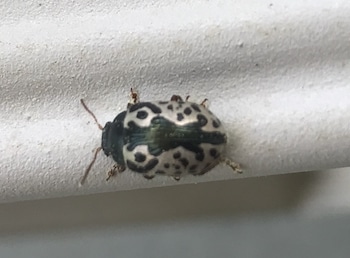
The name Calligrapha beetle is derived from the unique physical appearance of these beetles’ when compared to other beetles of its family.
Calligrapha beetles have patterns on their skin, which are more akin to the art of calligraphy …and so were used as a basis for their name – hence Calligrapha.
Like most beetles, including Ladybugs, the Calligrapha beetle’s body is a structure of four main parts, being antennae, head, thorax, and elytron (a casing/cover) that protects the wings of a beetle).
In the Calligrapha beetle, the head and the thorax usually reflect a dark metallic color, whereas the wing cases (Elytron) are ivory with different colored dark lines, patterns, and marking that reflect a calligraphy-style appearance.
The antennae, legs, and mouthparts tend to a dark in color. The colors, patterns, marks, and designs can vary depending on the species.
Species and variations
Calligrapha beetles come from a variety of species.
Most of them come in color variations of red, orange, green, yellow, and hues somewhere in between. But the most common type and the one this article focuses on is the white calligraphy beetle.
They reflect a gleam almost like that of an engraved jewel. Each species of Calligrapha beetle is unique, especially with a unique pattern of a black marking on the elytra (wing coverings).
Calligrapha beetles reflect a gleam almost like that of an engraved jewel
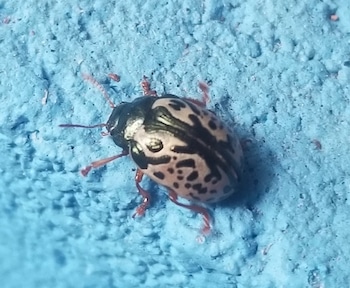
Different species have different identifiers/descriptors such as two-toned, spotted, flying, leaf, lined, shiny, metallic, and winged.
All species, in general, are small and round/oval. The size of an adult varies from 0.35 to 0.47 in (9mm-12mm).
Some of the Calligrapha species tend to represent a white/cream color, especially the species such as Calligrapha bidenticola and Elm Calligrapha.
Such white Calligrapha beetles tend to have patterns in black or brownish-black.
This mix of color and pattern, which is white or off-white with black lines or patterns is similar to that of a white ladybug.
This is why some confuse the Calligrapha beetle to be a white ladybug.
Is the Calligrapha beetle a good bug?
The elm Calligrapha species tends to be found in many outdoor plant areas feasting – and unlike Ladybugs, the Calligrapha beetle of any variety is not a good bug for your plants.
So with people seeing more of this species, they believe all Calligrapha beetles to be white and mistake them to be white ladybugs and therefore harmless to their backyards. Sadly they can and will feed on and damage your crops and plants.
Apart from this, different species of Calligrapha beetle also leave different patterns of bites on plant materials.
That is different species bite/feed on leaves in different shapes such as oval leaves, round leaves, and so on.
Also depending on the species, Calligrapha beetles feed on different plant parts and materials.
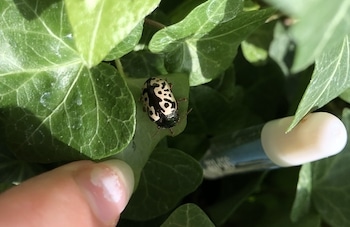
Calligrapha beetle – Location
Although the territorial reach of the Calligrapha beetle is unsure, it’s believed to be mostly native to New Mexico and surrounding states.
Over time though, the Calligrapha beetle has expanded its reach and establishment to the other states of America, Australia, and all the way to Europe.
I receive reports and images from many countries and places showing Calligrapha beetle sightings. In North America, I’ve received images from as far north as Canada.
I’ve added some images to the Calligrapha beetle gallery below.
Calligrapha beetle – Habitat
The habitat of Calligrapha beetles varies depending on the species.
In general, most of them can be found in and around outdoor plants as they are all leaf eaters and falls into the category of leaf beetles.
For example, the elm Calligrapha beetle, which many often mistake to be a white ladybug can obviously often be found in elm trees.
So while the elm Calligrapha beetle is named after its main source of food, the habitats of Calligrapha beetles can vary from forests, parks, woods, commercial properties, and houses.
Calligrapha beetle – Food source
As Calligrapha beetles fall into the taxonomy of leaf beetles, they feed on leaves and plant tissues. Calligrapha beetle can feed on all the leaves of a small plant.
Dogwood, basswood, elm, and other shade trees are some common plants Calligrapha beetles feed on.
When these beetles feed on older or well-established plants, they have the opportunity to recover themselves supported with good environmental factors.
But unfortunately, young plants that are not fully established stand more chance of perishing after these beetles feed on them.
As such to protect your young or tender plants from Calligrapha beetles, you may need to be vigilant, or even need to adopt some pest control methods.
Only this will help young or tender plants survive any vigorous Calligrapha beetle activity.
However, in general, when compared to other beetles, Calligrapha beetles are not considered a significant pest in the yard, and can even be appreciated for their unique physical appearance and properties.
Calligrapha beetle – Gallery
To help you identify your own beetle, here’s a selection of Calligrapha beetle photos sent in by my readers…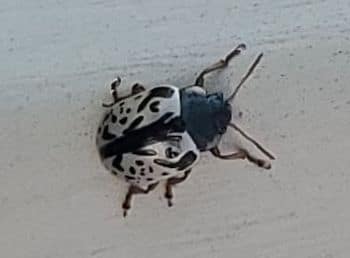
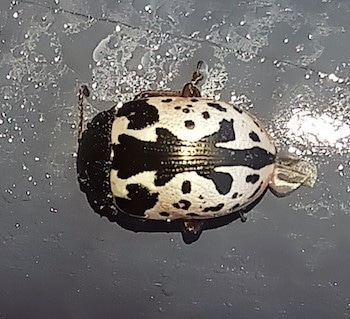
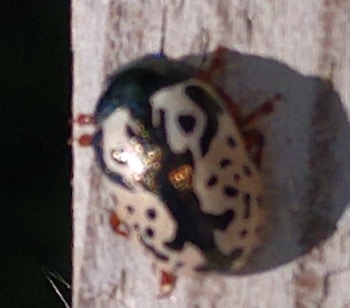

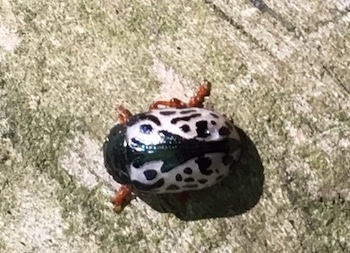


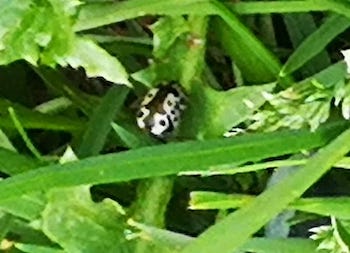
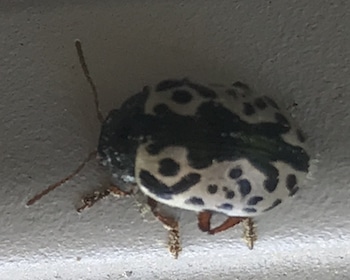
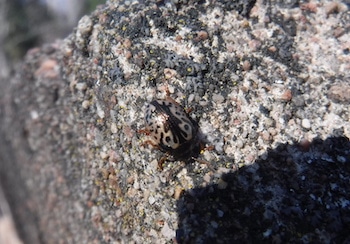
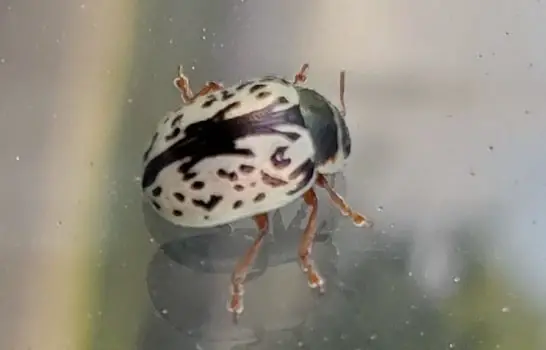
Image contributors: Ariel Bakke, Susan Durrenberg, Jordan Bourdages, Brie Walsh, Nancy Nam, Susan Mills, Marcelle Marcotte, Island Girl, Karla Soyring, Adrianna DiPietro. Thank you x
Calligrapha Beetle – To finish…
Thank you to all those who have contributed their Calligrapha beetle findings and images. I’m unable to name you all but you know who you are 🙂
If you would like them removed then please do contact me. But because of your contributions, I am no longer searching for images of the Calligrapha beetle.

